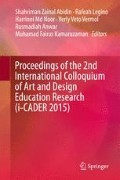Abstract
Scandinavia is a patchwork of Northern European nation states that form a cultural and regional entity that is very distinct from the rest of Europe. They deeply embedded design in every facet of their culture, from a piece of print media to huge city planning, in which kind of strategy in structure countries also promote a common national belief, values, and attitude in addition to driving togetherness among societies and helping to create national unity. Instead of creating unity in societies, this idea also results in a cultural comprehensive overview of functions and aesthetics to present democratic values, pragmatism, social equality, ingenuity, and resourcefulness. The other successful country based on cultural adaption in design, Japan, has a long history of combining the newest technology with clever, striking, and intricate design aspects. Japanese products that are deeply rooted in the concept of lifestyle and reflect the personalities of their designs in return, result in the traditional aesthetic of monozukiri, or “the art of making things”. In this case, the appreciation of design is elevated because design expresses national and local character, and character of the individual to pursue a common nature and this linkage of relations generates social development and fulfills their people’s needs. From both Scandinavian and Japanese design, it can be stated that they have gloriously created their national unity through design. There are no permanent studies of formulation of country’s design DNA, however, this research tries to search for Malaysian product DNA using a genetic algorithm as a generative tool that will indirectly share common features and appreciate the Malaysian identity.
Access this chapter
Tax calculation will be finalised at checkout
Purchases are for personal use only
References
http://www.ssig.gov.my/ssig/kcent/material/1malaysia_-_english_version[1].pdf (Date assessed March 26, 2011).
Fallan, K. (2012). Scandinavian Design Alternative Histories. ISBN 9781847889119.
Peterson, S. (2012). Scandinavian design: profit from design. http://www.huffingtonpost.com/soren-petersen/scandinavian-design_b_1337847.html.
Hagiwara, S. (2006). Origins-The creative Spark Behind japan’s best product Designs. Tokyo ISBN 9784770030405.
Onur Müştak Çobanlı. (2013). Design DNA Approach For Defining “Styles”. http://www.onurcobanli.com/publications/INTED2010/paper.pdf.
Karjalainen, T. (2004). Semantic transformation in design: communicating strategic brand identity through product design. Helsinki: University of Art and Design.
Eves, B., & Hewitt, J. (2009). Style-branding, aesthetic design DNA. International conference on engineering and product design education 10 & 11 Sept 2009. UK: University Of Brighton.
Cobley, P., & Jansz, L. (1998). Semiotics. UK: Icon Books.
Crow, D. (2003) Visible signs, AVA Publishing.
Barthes, R. (1996). Mythologies, trans Annette Lavers. London: Vintage.
The Structures of DNA and RNA. (2012). biology.kenyon.edu/courses/biol63/watson_06.pdf.
Watson, J. D., & Crick, F. H. C. (1953). A structure for deoxyribose nucleic acid. Nature, 171, 737–738.
Yongqing, Li. (2009). Development Of As-Manufactured Cad Model For The Concept Of “Product DNA”. Ph.D. thesis, University of Michigan. http://deepblue.lib.umich.edu/bitstream/handle/2027.42/63759/yongqing_1.pdf?sequence=1.
Zhang, M. (2007). Measurement scheme and classification methods for the development of a “Product DNA” concept in manufacturing. Ph.D. thesis, University of Michigan. http://deepblue.lib.umich.edu/bitstream/handle/2027.42/63759/yongqing_1.pdf?sequence=1.
Melanie, M. (1996). Introduction to Genetic Algorithms. A Bradford Book The MIT Press. Cambridge, Massachusetts: London, England. ISBN 0−262−13316−4 (HB), 0−262−63185−7 (PB).
Lee, H. C., & Tang, M. X. (2004). Evolutionary shape grammars for product design. In Proceedings of Generative Art 2004. Milan, Italy.
Back, T. (1996). Evolutionary algorithm in theory and practice: Evolution strategies, evolutionary programming and genetic algorithm. Computer Science Department, University of Dortmund: Oxford University Press. ISBN 978-0195099713.
Acknowledgments
The authors gratefully acknowledge the contributions of MIMOS designers, Universiti Teknologi MARA (UiTM) for funding this research under the Excellence Fund, and Research Management Centre for the administrative support.
Author information
Authors and Affiliations
Corresponding author
Editor information
Editors and Affiliations
Rights and permissions
Copyright information
© 2016 Springer Science+Business Media Singapore
About this paper
Cite this paper
Yusof, W.Z.M., Misri, I., Yahaya, M.F. (2016). Genetic Algorithm as a Generative Tool to Search for Malaysia Product Design DNA. In: Abidin, S., Legino, R., Noor, H., Vermol, V., Anwar, R., Kamaruzaman, M. (eds) Proceedings of the 2nd International Colloquium of Art and Design Education Research (i-CADER 2015). Springer, Singapore. https://doi.org/10.1007/978-981-10-0237-3_13
Download citation
DOI: https://doi.org/10.1007/978-981-10-0237-3_13
Published:
Publisher Name: Springer, Singapore
Print ISBN: 978-981-10-0235-9
Online ISBN: 978-981-10-0237-3
eBook Packages: EducationEducation (R0)

